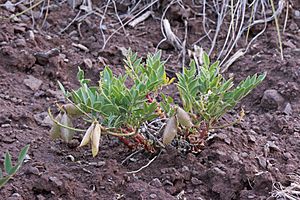Isely's milkvetch facts for kids
Quick facts for kids Isely's milkvetch |
|
|---|---|
 |
|
| Conservation status | |
| Scientific classification |
Astragalus iselyi is a special and rare flowering plant. It's also known as Isely's milkvetch. This plant belongs to the legume family, just like peas and beans! You can only find it growing naturally in Utah, in the United States. This means it is endemic to Utah.
Contents
Isely's Milkvetch: A Rare Utah Plant
This plant is a perennial herb, meaning it lives for more than two years. It can grow up to 25 centimeters tall. That's about the length of a standard ruler! When it blooms, it has pretty yellowish-white flowers. Each flower is almost 2 centimeters long.
What Its Fruit Looks Like
After the flowers, the plant produces a fruit. This fruit is a type of legume pod. It looks like a small, inflated balloon. The pod can grow up to 3.8 centimeters long. It also has a rough, hairy surface.
Where Isely's Milkvetch Lives
This unique plant grows in only three specific areas. All these places are in southeastern Utah. Two of these spots are in San Juan County. The third spot is in Grand County.
Special Soil Conditions
Isely's milkvetch needs very particular soil to grow. It only thrives in soils that come from certain rock formations. These are the Morrison and Mancos Formations. It might also grow in soil from the Paradox Formation. These soils are rich in clay. They also contain special minerals like selenium, gypsum, and uranium.
Why Isely's Milkvetch Is Threatened
Because this plant grows in such specific places, it faces some challenges. One of the main threats is uranium mining. This activity takes place in the same areas where the plant lives. When mining happens, it can disturb or destroy the plant's natural home. This makes it harder for Isely's milkvetch to survive and grow. Protecting its habitat is important to keep this rare plant safe.


